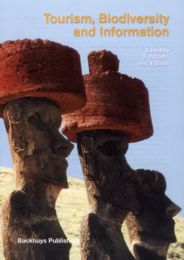

From the prologue
The year 2002 has been designated
by the United Nations as the International Year for Ecotourism, and this book
edited by Prof. Francesco di Castri and Dr. Venkataraman Balaji on ‘Tourism,
Biodiversity and Information’ comes as a very timely one. The starting
point for designing sustainable ecotourism programs will be in biosphere reserves,
national parks and other biodiversity-rich areas. Such programs have to be designed
in a manner that they help us to realize the following Seville Vision of Management
of Biosphere Reserves in the 21st Century:
Rather than forming islands in a world increasingly affected by severe human
impacts, biosphere reserves can become theatres for reconciling people and nature.
They can bring the knowledge of the past to the needs of the future.
Unless ecotourism methodology fosters an economic stake in conservation, it
will be difficult to make tourism ecofriendly. This is why a very carefully
designed participatory planning methodology will have to be developed along
with local communities.
The 28 chapters of this book cover many facets of the relationship between tourism
and biodiversity. The case studies are exceedingly interesting and relevant.
I hope that the book will be read and used widely so that everyone in our planet
can understand the truth behind Mahatma Gandhi’s dictum:
Nature provides for everybody’s needs, but not for everyone’s greed.
Prof. M.S. Swaminathan, UNESCO Cousteau Chair in Ecotechnology and Chairman
of the M.S. Swaminathan Research Foundation, Madras (India). Former President
of The World Conservation Union (IUCN)
Contents
Foreword, Thierry Desmarest.
Prologue, M.S. Swaminathan.
Preface, Francesco di Castri.
Section I.
Relevance of Tourism and Biodiversity in the Information Society.
Introduction, Francesco di Castri and Venkataraman Balaji.
Chapter 1, The Trilogy of the Knowledge-Based, Post-industrial Society: Information,
Biodiversity and Tourism, Francesco di Castri.
Chapter 2, Sustainable Tourism Within the Context of the Ecosystem Approach,
Alexander Heydendael.
Chapter 3, Sustainable Development of Tourism: Principles and Practice, Gabor
Vereczi.
Section II.
Geographic Regions: the Coastal Zones. Introduction, Francesco di Castri, Michel
Batisse, Paul F. Wilkinson and Venkataraman Balaji.
Chapter 4, Mediterranean Tourism: Towards a New Deal, Pierre Bougeant.
Chapter 5, The Spread of a Non-native Marine Species, Caulerpa taxifolia. Impact
on the Mediterranean Biodiversity and Possible Economic Consequences, Charles-François
Boudouresque.
Chapter 6, Protecting for Ecological Integrity in a Coastal National Park: Visitor
Use in Pacific Rim National Park, Vancouver Island, Canada, Paul F. Wilkinson.
Chapter 7, Integration of Biodiversity in Cultural Heritage in the Development
of Ecotourism. A case study from Haida Gwaii (Queen Charlottes Islands), B.C.,
Canada, Sylvie Blangy and Jean-Louis Martin.
Chapter 8, El Camino del Gaucho: Tourism Evolution, Biodiversity and Landscape
Management from the Argentinean to the South-Brazilian Coastal Zones, Rubén
Pesci.
Chapter 9, Sustainable Management of Conservation and Tourism: the Gulf of Mannar
Biosphere Reserve in Southern India, Venkataraman Balaji and Vaithilingam Selvam.
With an appendix by Sumet Tantivejkul.
Section III.
Geographic Regions: the Islands. Introduction, Francesco di Castri, Jerome McElroy,
Pauline Sheldon and Venkataraman Balaji.
Chapter 10, The Impact of Tourism in Small Islands: a Global Comparison, Jerome
L. McElroy.
Chapter 11, Sustainable Tourism in Small Islands: the Case of Malta, Lino Briguglio
and Marie Briguglio.
Chapter 12, Bikinis and Biodiversity: Tourism and Conservation on Cousin Island,
Seychelles, Nirmal Jivan Shah. Chapter 13, Tasmania: Balancing Commercial and
Ecological Interests in Tourism Development, Michael V. Conlin. Chapter 14,
Islands and Coral Reefs, Population and Culture, Economy and Tourism: World
View and a Case Study of French Polynesia, Bernard Salvat and Claire Pailhe.
Chapter 15, How Tourism Reduces Geodiversity and How it Could Be Different:
the Cases of the Galápagos Archipelago and Easter Island, Christophe
Grenier.
Chapter 16, Diversification, Connectivity and Local Empowerment for Tourism
Sustainability in South Pacific Islands – a Network from French Polynesia
to Easter Island, Francesco di Castri. With an appendix by Edgard Hereveri.
Section IV. New Trends in Biodiversity Conservation. Introduction, Francesco
di Castri, Peter Bridgewater, Jacques Blondel and Venkataraman Balaji.
Chapter 17, Biosphere Reserves, the Ecosystem Approach and Sustainable Tourism
– Finding